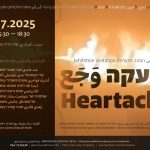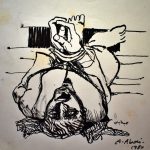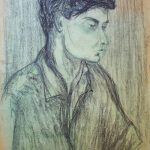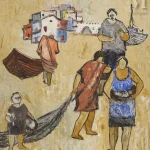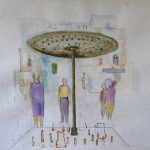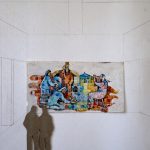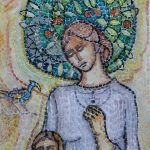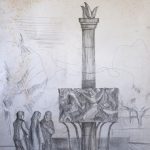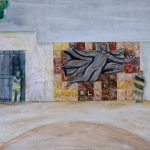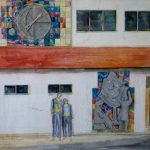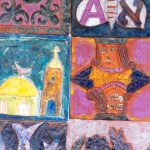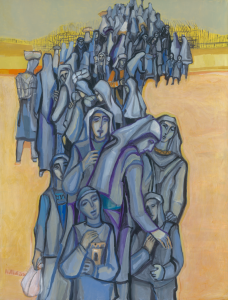
(1) Academic studies in Germany and its influence on his art
During his academic studies in the German city of Dresden, the young artist Abed Abdi was zealous and diligent in getting acquainted with all aspects of the sculpturing arts, including the baroque and neo-classical architectural arts, which are the 2 characteristic strands of architectural art dominant in the capital city of the kings of Saxony, in particular, during the period of Augustus II, nicknamed “the Strong”, who had built the palaces of Pillnitz and Weiße Hirsch on the outskirts of the city.
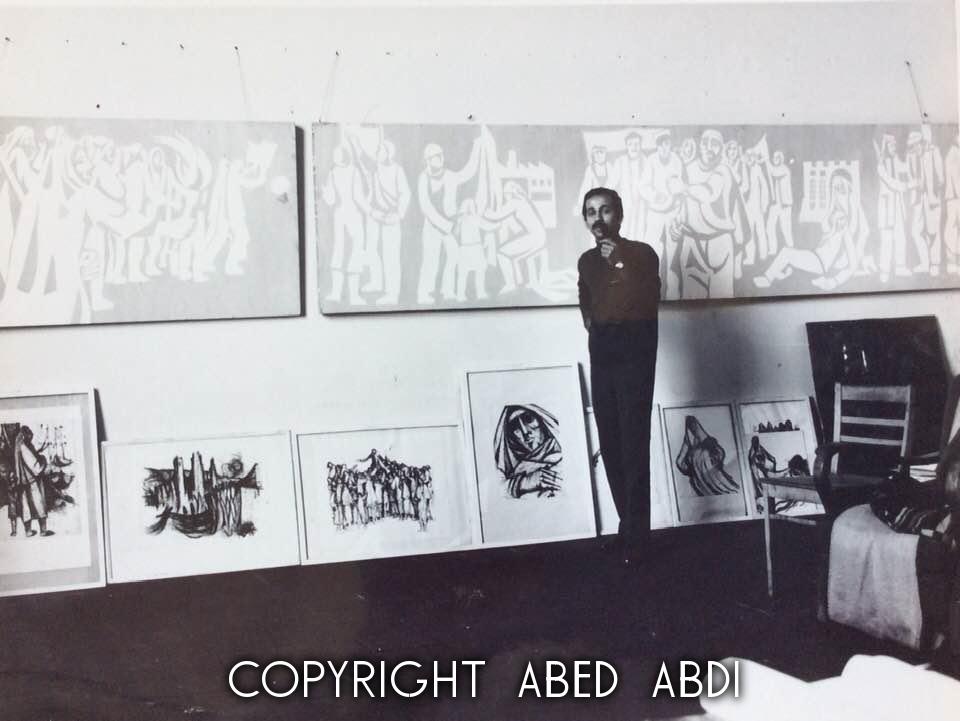
His interest in these cultural landmarks, which were almost completely destroyed by air raids and powerful bombs that led to the burning down of the center of the city of Dresden on the 15th of February 1944, had a profound impact on the works of the young artist Abed Abdi. This is due to the fact that, he too, was afflicted as a result of the war which ravaged his nation in 1948, and the wars which followed in Indochina, in Korea and after that in Vietnam, in addition to the wars of national liberation in Africa, the Cuban revolution, and the liberation struggles of the peoples of the third world.

Those events greatly contributed to polishing his humanist inner consciousness, this in addition to the profound influence of the German humanist culture, represented by the best of its writers and artists, like Goethe and Schiller (in the 18th century), Albrecht Dürer and Grünewald (in the 16th century), the musicians Beethoven and Bach (in the 18th century), the Hungarian / German Franz Liszt and the musical revolutionary Richard Wagner.
He was also greatly inspired when visiting the huge Zwinger museum, and the House of Opera, named after its designer Semper, and was also inspired by the “Our Lady” Cathedral, which was also destroyed during the second world war and was later rebuilt. Inspiration came also from the royal palace, as well as from the building of the academy of arts, which was built as part of the compensation due from France, which had lost the war during the first Napoleonic invasion of Germany and Russia.
Thus, it was not a coincidence that the student Abdi chose to pursue his art studies in this part of Germany, and longed to become the student of the late artist Käthe Kollwitz – the painter of the miserables, the displaced and the poor. It later became known that Käthe Kollwitz died during the second world war, as she was persecuted by the Nazi regime. Her statue “Mother with her Dead Son”, is an important landmark of the city of Berlin today.
Lea Grundig and other teachers at the Academy
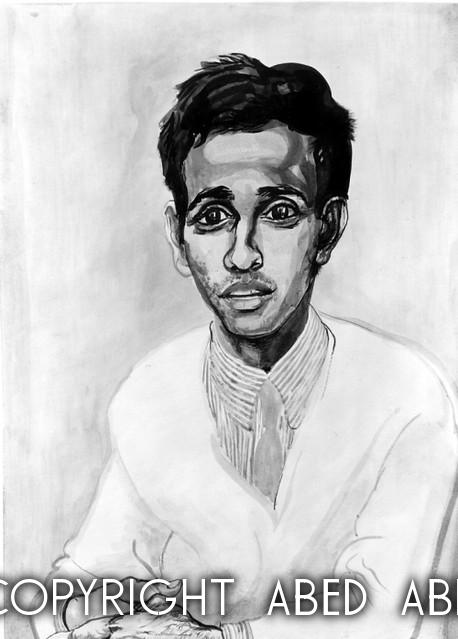
It was not a coincidence that the young artist met his first art instructor, the German artist of Jewish descent, who had learned graphic art and sculpturing from Käthe Kollwitz herself before the war, and who was also persecuted by the regime due to her Jewish religion. Her husband Hans Grundig was persecuted too, due to the fact that he was an artist and a communist at the same time, belonging to a group of artists from Germany called the “Degenerate art – entartete Kunst”,
In addition to the good relationship of the student with his academic instructors, a special relationship tied Abdi culturally with Lea Grundig, as both were on the side of the the nations opposed to imperialism, opposed to the Israeli aggression on the Arab lands, and opposed to the subjection of the Palestinian People to an occupation still ongoing until today.
One also ought to note here the distinctive relationship with a group of his teachers, in particular with his academic instructor professor Gerhard Bondzin, who had selected the student Abed along with a group of other graduating students, to participate in the erection of a huge wall mural at the Cultural Palace (Kulturpalast), built in the year 1968 in the center of the city of Dresden, a mural which remains until now a cultural landmark of this part of united Germany.
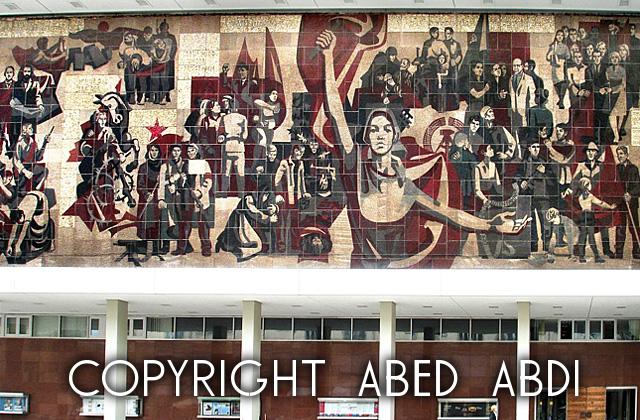
The achievement of erecting this creative work, done with a group of artists, as well as the prize awarded by the state as a reward, had contributed to crystallizing the future vision of Abed Abdi’s creativity for the public good, according to which visual art is able to contribute to the creation of artistic climates, which can give expression to the hopes of the society in achieving development and welfare. Consequently, he laid out the final design for the award of his masters diploma, which entailed the erection of the first monument titled “solidarity”, part of which was actually built within the compound of the academic institute in the city of Erfurt. This was accompanied by the theoretical study, submitted as his thesis for the award of the academic degree, titled: “monuments and their relation with the architectural and social spaces”.
In the group of illustrations of Abed Abdi titled “The Refugees” printed in black and white, which are part of the art works he created towards the final stage of his studies, the persons who play their dramatic roles in the Palestinian landscape seem as if they are in the space of another world, taken perhaps from the German drama, from the years 1905-1923, when several artistic movements sprung up one after the other, such as the “Die Brücke”, which was established in the buildings of the academy in which Abed Abdi had been a student. This in addition to the “Der Blaue Reiter (The Blue Rider)” movement, which was established in the city of Munich, as an expression of opposition, and struggle for the freedom of expression of the individual and the group.
While the young artist had worked with the art of printing driven by premises touching upon the case of his people, in their episode as Palestinian refugees and the six day war, and while he has used the art of printing as a public tool to publish the works so that they would get to the wide public, the “protocols” of the manifest of the German artistic movements, in particular the expressive movements, were the initiators of this approach – as art must be impulsive and able to recruit people.
The seven years spent by the artist Abed Abdi in this part of Germany have made a great contribution in allowing him to gain knowledge and expertise in the fields of printing art techniques, lithographic printing and itching on copper and wood plates, as well as the art of net printing. In addition, Abdi learned aspects of sculpturing art, and later on he specialized in the arts of the wall murals. These specializations have also contributed to opening up worlds, which were kind of closed and unknown to him before he arrived there to study.
“Architectural art, and the arts of the Gothic period in Germany has its own characteristics, which is different from that in Italy or France, in that it has emotional influences, which had some impact on my later art work in the drawing of lines and then the wall murals”
In more than one interview, Abdi mentions these words when he speaks about his interest in the arts of the Gothic period, particularly those art works created during the evolution of the church reformatory movements, as that led by the religious thinker Martin Luther, and those created during the thirty year war between the Catholic and the Calvinist fractions, describing the impact this has had on the artists of that period, and among them Albrecht Dürer, Holbein and Grünewald.
Albrecht Dürer was born in 1471, his father was of Hungarian origin, who had moved to the southeast of Germany, to the city of Nuremberg, a city which served as a soul-stirring location during the civil war. That war had a profound impact on the works of Dürer, in particular, on the series of printings carved on zinc plates, and the lithography printings, as well as the oil paintings – all inspired by the miserable life of the poor citizens of he villages, and by the feudalistic oppression reflected in religious fundamentalism. All of these were transformed in the works of Dürer, Grünewald and their friends in the Netherlands (such as Bruegel the father, Rembrandt and van Delft) into a reflexing tool, reflecting through this transparent humanist creative mode of expression the weak and the miserable of this earth, whom long to a sky and a space which would bring them back at least a little of their freedom and والانعتاقwelfare .(?)
Those strands of the creative schools of art throughout the centuries have had a visible impact on the works of Abed Abdi, which he created during his studies in the city of Dresden. That appears vividly in a collection of works printed on carved wood, carrying the title “refugees from the so called six day war”, which is a group of 6 works of art, in which he presents the Palestinian motif, showing the state of devastation, and the scattering of the Palestinian people as a result of the Israeli aggression, which is still present in that tragic motif until today.
Other influences reflected in the works of the artist originate from the works of Italian artist Renato Guttuso from the sixties of the last century, which had a sensible influence on the works of Abed Abdi. This, of course, in addition to the greatest influence originating from the works of the giants of Mexican art Rivera, Siqueiros and Orozco. It ought to be mentioned here that Siqueiros had visited the Dresden academy of art in 1969, and had met a group of lecturers and students, among them Abdi.
Abdi told Israeli critic Lea Tsemel in an interview published in 1980: “Rivera and Siqueiros have had an important influence in the later stages of the vision which I have suggested, and which I am proclaiming for the future as well, since the Mexican contemporary artists are laying out the same vision in making the art of wall murals painted on the fronts of houses and governmental and public institutions is a target for raising awareness and encouragement, and this is an alternative to the museum which is not in action, and which is not capable of influencing the public”.
The artist Siqueiros had written in the twenties of the last century:a manifesto he circulated to a group of progressive artists, later called the “Union of Technical Workers, Painters, and Sculptors“. It stated:”We repudiate the so-called easel art and all such art which springs from ultra-intellectual circles, for it is essentially aristocratic. We hail the monumental expression of art because such art is public property. We proclaim that this being the moment of social transformation from a decrepit to a new order, the makers of beauty must invest their greatest efforts in the aim of materializing an art valuable to the people, and our supreme objective in art, which is today an expression for individual pleasure, is to create beauty for all, beauty that enlightens and stirs to struggle.”
In the defense of his “diploma” thesis, equivalent to a masters degree, the student of arts explained the stages of the work as well as his future vision, which he will pursue after returning to his homeland, and defining his targeted creativity for the public good. In his reply to a question by one of the examining professors, he stated that “the Palestinian minority in Israel does not have a museum, nor an appropriate room that would store our cultural and folk heritage, due to he policy of intentionally ignoring the Palestinian minority which has stayed in its homeland. Additionally, the society of creative cadres like visual artists, musicians and actors suffers from the lack of supportive and encouraging public. Therefore my work will deal with the art of wall murals, the art of printing and posters, and will strive to transform the creative approach in the public sphere in order to create a cadre of young creative creators, as well as the general tasters of art.”
(2) Abed Abdi and the instruction & training of young Palestinian artists
The artist Kamal Boulata, in his introduction to the the chapter about the state of underdevelopment of Palestinian art in the Galilee, stated in a lecture he gave during the convention of the Arab communities in the United States in 1975, which was published in a number of Arab newspapers and magazines, among them the Al Jadeed newspaper published in Haifa, and which was translated by the late actress Bushra Karaman:”What draws attention in the appearance of Palestinian art by the Palestinian minority in Israel is the endeavor of a small group of young artists to study art at the academic level, and these are: the late Ibrahim Ibrahim from Reineh village in the Galilee, Abed Yunes from ‘Ar’ara village in the Triangle, Khalil Rayyan from the city of Tamra and Abed Abdi, who has returned from Germany a number of year ago. The later has contributed in a special way in activating and recruiting artistic paths and young artist cadres, who began their careers in painting wall murals in the city of Nazareth and Kafr Yaseef, where the first arts course was initiated and led by Abed Abdi, a course which is active in the creative and public fields”.
It ought to be mentioned that this course was the nucleus, from which well known
artists graduated like Ibrahim Nubani, Ilia Beeni, Kamal Milhelm, Samer Miari and
other creators. It also served as the catalyst for the establishment of the first artist association for the Arab artists “Ibdaa”, in 1994 in the village of Kafr Yassef.
Arabelle: Association for the advancement of the visual arts
Abed Abdi is also the founder, along with other intellectuals from the Haifa region, and president of Arabelle, a not-for-profit association that was founded in May 2005 in Haifa, Israel. The creation of the association came to promote social and cultural ends, which are primarily related to the development of the culture of art by the Palestinian population of Haifa and its region. The goals of Arabelle are summarized in the footnote below. As part of the activities of the association, Abdi is currently teaching visual art for more than 20 children and some of their mothers.
The motivation behind this endeavor is explained by my father’s own words below:
“ The workshop will supply a proficient response to the development of young talents. It will hold courses for ceramics, color and illustration, as well as environmental sculpturing – for both children and advanced students of art. The workshop thus aims at introducing school children and high school students to various artists and art segments, and to enable them at the same time to get acquainted with the various techniques and materials.”
(3) Monuments, Murals and other Witness Bearers Created By Abed Abdi
In addition to his various activities of art training, organizing and holding group and solo exhibitions, and his participation in numerous creative workshops both inside and outside the country, artist Abed Abdi has also erected a number of monuments and murals in the following locations:
The Land Day Monument with Gershon Knispel at Sachneen (1977).
Environmental sculpturing, Nahef (Galilee) (1982).
Mosaic mural at Ebellin College, Ebellin (1983).
Mosaic mural at the yard of Roman Catholic Church “House of Grace” in Haifa (1984).
The monument commemorating 75 years of status as city in the year 1984, renovated by Abed Abdi in the year 2010, Shefa-‘Amr, Galilee: capital of Daher Al Omar
Designed the memorial and grave of lawyer Hanna Nakkara in Haifa (1990).
Erected a monument in the garden of the National Museum of Amman, titled “homage to the city of Amman”, during a workshop of sculptors and creators from the Arab world held in Jordan in the year 1998, and which was revealed by princess Wijdan Ali, the President of the Royal National Museum.
Designed the memorial and grave of Palestinian writer Emil Habibi “Staying in Haifa” (1998), Haifa.
Designed entrances of the municipalities of Iksal, Reinah and Eilaboun 1998-2000.
The monument commemorating the martyrs of the Galilee village Kafr Kana (1999).
mural knowledge and Science at the garden of Ort school at Zarazir village (2005).
Tree of Knowledge statute at the garden of Ort school at Zarazir village (2005).
The monument commemorating the martyrs of the village of Kafr Manda (2001).
“Shining Sun” mural at Ebellin elementary school, Ebellin.
Co work created by the artist in a creativity workshop for Arab and Jewish and German youth in the yards of the famous German school “Odenwald” close to the city of Heidelberg in Germany (2004).
Statute of the philosopher worker at the yard of Alshifa medicine factory in Ramallah (1999), and its first bronze statute to be erected in the Palestinian space.
Pillar for Friendship and peace, created at the historical Ironbridge city in the UK in 2007 on the initiative of BABA – the British Artist Blacksmiths Association. The Pillar includes works by master blacksmiths from around the world, including the work by Abed Abdi.
The Land Day Monument
It is the first large scale monument created in the Palestinian space, in the Galilee city of Sachneen, by artist Abed Abdi and with the cooperation of his friend, the Israeli artist Gershon Knispel. The monument was erected to commemorate the memory of 6 land day martyrs, who were killed in defense of the land, honor and equality, as result of Israeli expropriation of lands in the axis of the villages of Deir Hanna, Arrabe and Sachneen, and as a result of the politics of arbitrary oppression by the successive Israeli governments against the Palestinian people who have remained in their homeland.
The memorial monument, which has been erected inside the Muslim cometary, due to the refusal and threats by the regional construction and planning authority, that if it is erected in the flat architecture of the village, then it will be destroyed. The monument was revealed on the 30th of March 1977, on the second anniversary of the bloodbath, with the presence of thousands of Arab and progressive Jewish citizens.
For th construction of this historical monument, the help of a cadre of builders was used, who built the base of the monument from enforced concrete, and then in the assembly of the several figures made from melted aluminum cast into a mould, and which tell the story of the monument through the presentation of the images of the mother bereft of their children the martyrs, and the defenders of the land and those remaining on it.
The monument was built in the shape of sarcophagi which is a rectangle sepulcher made out of marble, on which special motifs were inscribed of faces and ornaments which had characterized the art of funeral in the classical Greek period and later in Roman times as well.
On the third anniversary of “Land Day” Abed Abdi and his friend, Gershon Knispel, published the Land Day Album titled “The Story of the Monument”, to which poet Samih al-Qassim, and writer Joshua Sobol also contributed their writings. The album included photographs as well as the designs, which were inspired from reality as lived by the Palestinian situation and the struggle of people generally for a better society. The album was published in 1978 in numbered editions all signed by the artists.
My father had the following remarks about that monument: “The peoples of this earth have invented during their creative civilizational procession expressions of their thinking in the shape of forms and signs, clearly visible in the temple, the house of prayrs, the various obelisks and the stone monuments. During this human procession and the succession of generations, these tools become symbols and expressions of an age gone by in the folders of time, but it wont be deleted. Generations come and go in all of these stages, leaving behind the memory, while holding firmly to the present. This present that is touched by palm trees standing firmly, and by the depth of the cacti roots, and by the lofty deserted mosque and the bells of the church that one cant hear because of the rust spreading sadness in the air. This sequentiality has occurred in the not so distant history, the wounds of which have touched upon the bulges of the stones which are standing still in front of the bulldozers of civilization. I have tasted the salty sweat pouring on the brown faces, that sweat which has been transformed through the sad history into tears shed on the graves, which have turned into monuments in Sachneen, Kafr Qasem, Tantura and Deir Yaseen. This monument we have erected in Sachneen is the testimony and oath of belonging eternally to this land, which has lost its sons while defending their mother.”
He also stated in the Land Day Album the following: “Our common work with my friend Gershon Knispel is an embodiment of the idea of creative collaboration between the sons and daughters of these 2 peoples in order for the tragedy not to be repeated, and that it is hoped that the work for the present will hand to the future monuments for peace and for our joint existence on this land”.
“Holiday of Holidays” in Haifa
Since 1997, Abed Abdi has been permanently taking part in the creative art section of the project “Holiday of Holidays” in Wadi Al Nisnas (the neighborhood were both Abdi’s house and studio are located in downtown Haifa).„Holiday of Holidays” is multicultural event, taking place in Haifa each year through the whole month of December, celebrating the Christian, the Muslim and the Jewish holidays.
This participation entailed the erection of environmental sculptures in and around the neighborhood, some of which are still visible today on the walls of the houses in the narrow streets. Since 2007 Abdi is the co-curator of this open air exhibition, which now brings together more than 50 artists, Arabs, Jews and foreigners, who engage in environmental sculpturing in the neighborhood for the common good.
(4) Haifa the first homeland..
My grandfather Qasem was born in the city of Haifa in the year 1900 (its is said that he was actually born in 1898) to a father named Deeb Abdi, who was also born in Haifa in the year 1860 to an Arab Palestinian family.
The mother of my grandfather was named Zahra, and she descents from a Lebanese family named Al Mukhtar, originating from the city of Tripoli, nicknamed the “family of the virgin”. The family of my grandmother Khayriyeh Al Haj, originates from Lebanon and Egypt. The mother of my grandmother, Fatima Al Kalawi, has had Lebanese roots, while the Al Haj family descends from Egyptian roots. By this my father Abed Al Rahman Abdi, who was also born in Haifa, carries in his genes a cultural continuity stretching along the coast from Bur Fuad and the Kafr Lam estate close to Cesaria, Haifa, Sidon until Tripoli in Lebanon. Add to this that my aunt Lutfia Abdi Bedouan is still a refugee at the Al Yarmouk refugee camp, which is located nearby Damascus, together with her children, grandchildren, and grand grandchildren. She is still awaiting the return to the place where she was born, Haifa, but in vain.
During the study of my father in East Germany, and in the last part of his studies, he got acquainted with Judit from Hungary, while she was pursuing her academic studies in the city of Dresden in which my father had lived for 6 years. My parents then got married in Budapest, the capital of Hungary, in the autumn of 1971. My mother followed him to the Haifa, the city where I was born in may of 1972. After that my brother Attila was born, exactly on the day the curtains were removed on the monument commemorating the memory of the Land Day martyrs on the 30th of March 1977. In 1985 my youngest brother Jünell was born, at the period when my father started to work as a lecturer of arts at the Arab College for Education in Haifa.
Beside these thrilling happenings important for creating a small family, an interesting life ensued, combining civilizational and cultural elements from both the east and west, reulting in a disctinctive mix between what was and what will be. That mix was a reality in which I lived, together with my brothers, comprising a multitude of languages, varieties of life styles, traditions and ways of pursuing knowledge – all of which had to be reconciled.
My grandfather and Haifa in 1948
I was a witness to the scenes, when my father kept asking my grandfather Qasem Abdi to be so kind and sit down in front of my father at his studio, so that he would be able to draw his face in a painting titled “Ethnic cleansing of the Arab Citizens in 22 of April 1948”. My Grandfather initially repeatedly refused, but at the end he agreed. This is how this painting was created, which documents the scene of plight from Haifa in 1948 through the port, into an “unknown world”, as my late uncle Deeb Abdi used to say before his death in 1992.
My grandfather died in 1991, but his crinkled face and his gray hat made from wool remain at the center of the painting (above), which embodies the plight of the grater part of the Arab citizens of Haifa, through the sea and through dusty roads, to unknown worlds in the diaspora, and who die while eternally waiting to return.
The Intifada Series and my grandmother
The paintings drawn by my father which were inspired by the first Intifada, and the state of the Palestinian affairs at the end of the 90’s, had a profound impact on the humanist and spiritual affectivity, in particular the painting he drew following the death of my grandmother Khayriye in 1996, were she was covered with a shroud, just like those young men who were killed in all the uprisings (Intifada’s), bringing back to our minds memories of the rituals of the Pharaohs in the scene of death, and in the eternal shroud which covers their deceased, or what is known in the Jewish tradition as “Gniza”, that of collecting papers from the old testament, and keeping it from burial until the funeral actually takes place.
A Tale of 2 Paintings
A while ago when I was visiting Haifa, I was greatly humbled by two paintings I came across while documenting all paintings and illustrations of my father for posting them on his new website. The first was a photograph of my grandmother at a young age, wearing a black scarf from which delicate black hair scrolls down, and on her neck thoe pearls which accompanied her for long years.
That young lady seemed as if standing as a model in front of the Austrian artist Gustav Klimt waiting for him to draw her at the end of the 19th century. However, the background of this painting takes us to the worlds of the Palestinian refugee camps, where one sees the parts of the hessian and the textiles used as sugar bags or flour bags, which were distributed to the families of the refugees by the aid agencies.
The other panting: An image of my mother, first illustrated and then carved on wood and then printed, made by my father while he was a student. We have mentioned earlier that his works in the first years of study in Germany were influenced to some extent also by the German painter (of Hungarian origin) Albrecht Dürer.
The face motif appears as if covered with the Palestinian folk textiles, wrapping a lady who appears to be a European, who is expressing her solidarity with the core of the issues relating to this other nation, to our peoples.
Icarus in Haifa
There is another interesting painting, which was actually painted on the canvas twice: In the initial painting, my father drew my brother Attila as a boy trapped in between the buildings and small streets of Wadi Nisnas, surrounded by its houses. The idea of the painting and what resulted did not satisfy its creator, so he covered it with the white Geso material, and replaced it with the composition of the child flying towards the light, transcending the houses and getting higher, so as to brake away from his siege.
The subject of Icarus taken from the Greek mythology appears in more than one work of Abed Abdi, once one can see him without wings flying with his air carrier above the roofs of the Haifa neighborhoods, stretching the range of the carrier and its silver rope to far away, beyond the port and reaching Ras Al Nakura, the point from which my father returned with his mother, brother and sisters back home to where they were born, after having to stay at the refugee camps in Lebanon and Damascus, a state of affairs which lasted for 3 years. Their return was facilitated by what is called “family reunion on humanitarian grounds”.
In the other works from the series of the flying child, Icarus transforms into a handsome boy flying over earth with his carrier, just as they appear in the illustrations of Leonardo De Vinci, the great Italian painter. That painting was created by using net printing art, and was distributed in 30 copies, one of which was donated to Palestinian poet Ahmed Dahbour, son of Haifa, who is also a refugee. In return, Ahmed Dahbour wrote a poem dedicated to my father when he visited him in Haifa in 1997.
Endnote
This is the first time I write part of a biography still unknown, that which started with the journey of the artist Abed Abdi – my father – to Germany for pursuing his studies, as I have lived and grown up in the warmth of that home until leaving for my academic studies in the city of Budapest the capital of Hungary and the homeland of my mother.
It is hoped that the materials presented in this book will have contributed to becoming an important source in raising the issue of the visual arts of the Palestinian minority. It is also hoped that it will serve the cultural and civilizational continuity, as a documentation of the procession of Palestinian culture, along with its other mortal creative creators.
Amir Abed Abdi


